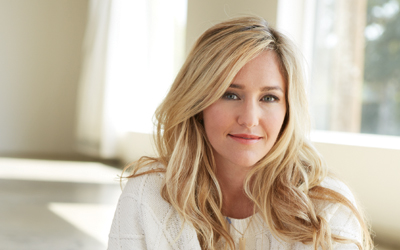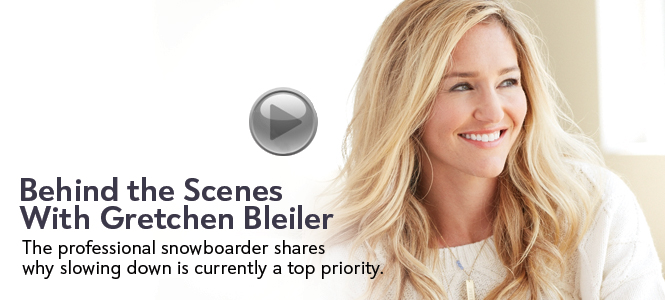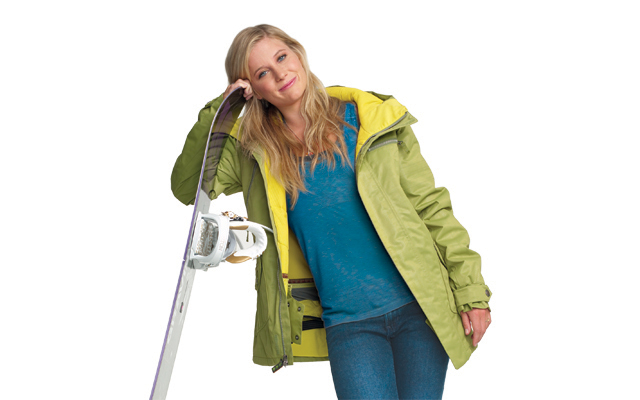In late June, professional snowboarder Gretchen Bleiler was practicing double back-flips on a trampoline in Park City, Utah, when — for just a split second — she lost control. “I knew in the air that I was spinning too fast, but there was nothing I could do about it,” she remembers. “I landed on my upper back with my knee in my face. I broke my eye socket and my nose, and I gave myself a severe concussion.”
The 31-year-old has beaten back minor injuries in the past and dominated half-pipe competitions at the Grand Prix and U.S. Open. She’s won four gold medals at the X Games and took home silver from the 2006 winter Olympics in Turin, Italy. But this past summer — which Bleiler describes as “scary, uncomfortable, nauseating, painful and disorienting” — proved to be the most challenging period of her career.
Still, Bleiler knew from experience that the best way through was to slow down, lean on loved ones and give herself plenty of latitude for an incremental recovery. “I think the only way you can come to peace with an injury like this is not to hide from it and instead explore it, feel it, dissect it and learn from it,” she says.
When I caught up with our cover model in October, she was just finishing up a training trip in New Zealand and was pleased to discover that, while there were a few things to work on before starting the 2013 season, she was “fired up to be in [the] best shape physically, mentally and spiritually” of her decade-long career. Bad news for the competition, perhaps, but great news for fans in search of inspirational role models, on and off the slopes.
EL | How did you get interested in snowboarding?
GB | I grew up skiing and I was getting bored with it. Snowboarding was this new thing and it was so exciting and free and more about style and individuality.
I’ve always been very athletic, and whatever I was participating in, that’s what I wanted to go to the Olympics with or be a pro at. With snowboarding there wasn’t a set path that you had to follow. People were making it up as they went along and I loved the freedom of that.
The type of people that snowboarding attracted really fascinated me and I was drawn to the lifestyle.
EL | What do you do to prepare yourself for competition?
GB | The women’s half-pipe is so technical now, so you have to be very strong. You’re not only training on the mountain but you’re in the gym to prevent injuries and build confidence. You feel more prepared when you are up on the hill and putting yourself in scary and dangerous positions because you’ve done everything you could up to that point.
When I’m having fun, that’s when things seem to go right. It’s easy to get into a place where you’re nervous and want to win and you feel yourself holding onto that. I’ve been competing for 10 years, so I know those signs when I feel like I’m holding on with my claws. What will happen will happen. I might as well have fun and not stress about it.
EL | How badly did you hurt your eye last summer, and what happened in the immediate aftermath?
GB | I blew out the sidewall closest to my nose and the floor of my eye socket, so they needed to build a titanium bridge to replace what had been there before. But because I had so much inflammation, I needed to wait a week before they could perform the surgery. That was a really hard week.
A day after the surgery, I started feeling so much better. Three months after surgery, I had made huge improvements. At this point I am still healing. What’s happened, because of the trauma from my accident, is that there is an eye muscle that is too tight and it’s preventing my eye from getting its full range of motion. This leads to double vision at the high point and low point of my vision. I was told before my eye surgery that there’s a chance I could have double vision when looking up for the rest of my life. But I’m a firm believer that we have the power to heal ourselves if that’s what we put all of our focus toward. I’ve looked elsewhere for answers now and I’ve seen amazing results.
EL | What have you done to take care of yourself, both physically and psychologically?
GB | Once I was back home in Aspen, Colo., I worked with an acupuncturist quite consistently for the first couple of weeks. I did a cleanse to flush the chemicals and painkillers of the surgery and to spark my digestion back into working order. I visited my chiropractor for some tune-ups and was referred to do cranial sacral work. I really believe all of these methods helped me tremendously. And I combined all of that with rest and relaxation and gratitude. Because it’s possible to be doing all of that healing, but if you’re rushing around and wearing yourself out, it won’t work.
EL | What did it mean for you, an ultra-competitor, to slow down and baby yourself a little?
GB | It was very foreign to do nothing for so long, but as I rested day in and day out I could feel and see my body healing right before my very eyes. So I knew that doing nothing was what I needed to do, and I started to like it! After 10 years of not having a real summer and just going like crazy, this was sort of a nice surprise. I do believe that your body will find ways of getting what it needs and it sends signs to let you know. The signs start out small, but if you don’t listen to them they get bigger. For me, this was a loud and in-my-face sign — literally — that my body needed rest. Unfortunately, it took this accident to get it. Next time I will listen to the smaller signs.
EL | Once you get back to your busy schedule, what will you continue to do to take care of yourself?
GB | That’s another valuable lesson that I’ve learned through snowboarding — it’s so important to have balance in every single day of your life. If you’re constantly running yourself down to the bone, that’s not a healthy or a happy way of living; even if you’re doing amazing things, you’re still tired every day.
Every day I try to be consciously grateful of where I am in life. I do a gratitude walk with my dog and husband where we talk about everything we’re grateful for, from the simple things like being healthy, being able to breathe and the heart pumping without asking it to, to living where we get to live and traveling to places we get to travel.
Check out Gretchen’s Behind the Scenes Video.




This Post Has 0 Comments